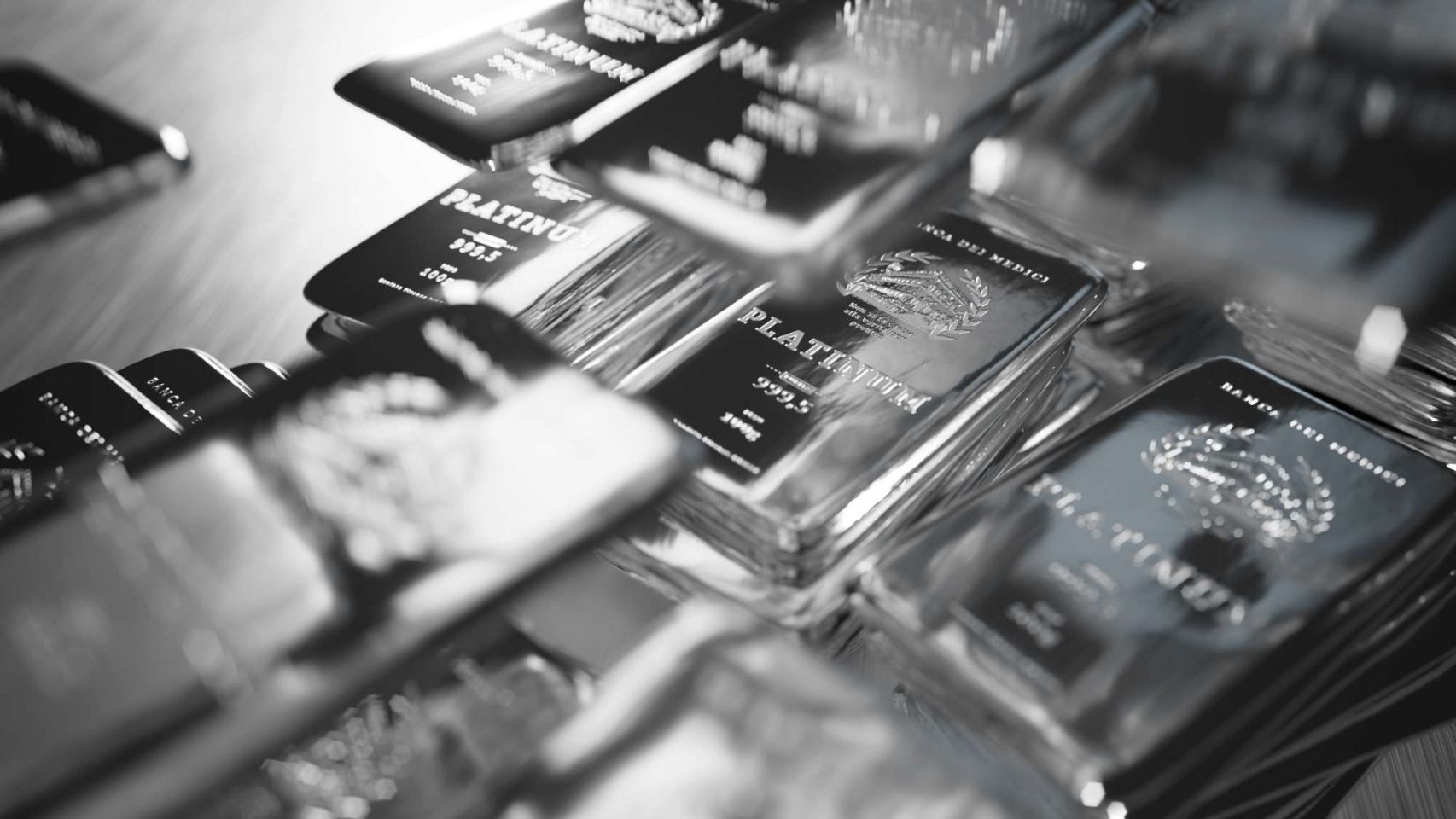Platinum trading explained: How to trade platinum

What is platinum trading?
Like silver and gold, platinum is a precious metal and valuable commodity.
Platinum is a dense, malleable and ductile element, forming the basis of the platinum-group metals (PGMs). This group consists of six metals with similar chemical and physical characteristics: iridium, palladium, osmium, ruthenium, rhodium, and platinum.
The metal is rarer than gold. In 2024, miners extracted around 170 tonnes of platinum, compared with about 3,300 tonnes of gold. The cost of mining per ounce is also generally higher for platinum.
Trading platinum involves gaining exposure to its price by buying and selling the physical metal; investing in companies involved in its mining or supply chain; trading exchange-traded funds (ETFs), options and futures; or using derivative products such as contracts for difference (CFDs).
History of platinum trading
Using platinum as an investment is a relatively recent development. Although the Italian scholar Julius Caesar Scaliger mentioned the metal in 1557, it was not traded as a currency like gold or silver.
Platinum commodity trading expanded during the 1970s, particularly after the New York Mercantile Exchange (NYMEX) introduced official platinum futures contracts in 1976 as a way for traders to diversify from agricultural products.
It was not until 1997 that the US Mint issued its first platinum bullion coin. These coins have since become widely recognised, alongside similar issues from other international mints.
Today, platinum can be traded through coins, bullion bars, futures, derivatives, and options contracts.
What is platinum used for?
Aside from its role as an investment instrument, platinum has a wide range of uses. A large share of demand comes from the automotive industry, where it is used to build catalytic converters – particularly for diesel engines – though palladium has increasingly been adopted in petrol engine catalysts.
Platinum is also used in jewellery, especially in wedding bands and engagement rings, valued for its durability and hypoallergenic properties. It has further applications in industry, serving as a catalyst in chemical production, as well as in electronics (including sensors and laboratory apparatus), glass manufacturing and medicine. In healthcare, it is used in medical devices, dental alloys, and platinum-based cancer treatments.
Platinum price history
Historically, platinum has been influenced by both investment and industrial demand, which is reflected in its price movements. In terms of global supply, South Africa accounts for the majority of production, giving the country a significant impact on market prices.
The platinum price chart shows that values rose from the late 1990s to reach an all-time high of $2,253 per troy ounce in March 2008 during the commodity boom. The price then fell sharply later that year as the global financial crisis took hold, trading at around $813 by November 2008.
Platinum rebounded to $1,872 in 2011 as the global economy stabilised, but declined to $785.50 in August 2018 amid oversupply. Prices trended higher until early 2020, before dropping to $586 in March 2020 as markets responded to the Covid-19 pandemic.
The metal climbed above $1,300 in February 2021, as lockdowns disrupted supply in South Africa and demand from the automotive industry picked up faster than expected.
2024 and 2025 price action
Platinum prices in 2024 were largely range-bound, trading between $875 and just above $1,080, with averages of around $895-$1,015. Movements were shaped by shifts in automotive demand, which reached a seven-year high early in the year, as well as trends in the jewellery market. Supply deficits exceeding 450,000 ounces and broader commodity dynamics contributed to this volatile but contained environment.
In 2025, platinum experienced sharper swings and greater volatility. Early in the year, prices averaged about $948 in January and hovered near $980 through February and March. In April, values dipped to $920-$995 amid continuing supply uncertainty. A sharp rally followed in May and June, briefly pushing prices above $1,400, driven by supply disruptions from South African mining challenges, Russian export sanctions and rising demand from green technologies and automotive catalytic converters.
Investor sentiment was unsettled by concerns over US import tariffs and acute leasing rate spikes, which exceeded 22% in June and intensified the squeeze. After a correction later that month, prices rebounded in July to peak at $1,474, before easing slightly in August to average about $1,332. Despite supply deficits exceeding 500,000 ounces, above-ground inventories helped absorb some of the pressure, resulting in a tight but highly volatile market.
Past performance is not a reliable indicator of future results.
What moves the platinum price?
Several factors influence the direction of platinum prices. The market is shaped by demand and supply, which are highly concentrated and can result in sharp price volatility.
Comparison with gold
Although platinum is not generally regarded as a traditional safe-haven asset, it can at times attract investors when gold prices are high, prompting comparisons between the two metals. Traditionally, safe-haven assets are often used as a hedge against downward trends in other asset classes.
Between 1987 and 2008, platinum frequently traded at a premium to gold, but the relationship changed during the 2008 financial crisis when gold moved above platinum and has mostly remained higher since. As gold is primarily an investment asset while platinum has strong industrial utility, investors tend to turn to gold during periods of economic uncertainty and to platinum when economic activity is stronger.
Supply and demand
Platinum is a scarce natural resource, so any changes in supply can have a substantial effect on availability and therefore prices. Demand is concentrated largely in the automotive and jewellery industries, alongside chemical and petroleum applications.
China is the largest consumer of platinum for jewellery and a major automotive producer. However, demand for catalytic converters has historically been strongest in Europe, where diesel vehicles are more common. Global consumption patterns therefore vary depending on regional industry dynamics.
Geopolitical conditions
The world’s platinum reserves are heavily concentrated in South Africa, with additional significant deposits in Russia and Zimbabwe. This means that events in these countries can affect supply and influence prices.
For example, Covid-19 restrictions in South Africa in 2020 reduced mining activity and supported a recovery in platinum prices after an initial decline. In 2022, Russia’s invasion of Ukraine raised concerns about the availability of Russian platinum. While sanctions did not directly target the metal, some participants reduced exposure, adding to supply uncertainty.
Jewellery market
Jewellery accounts for around 23%-29% of platinum demand, according to the World Platinum Investment Council (WPIC). The use of platinum in fine jewellery has grown in recent years, driven by demand from China. Rising demand from India could also accelerate its use in this segment.
Automotive industry
Around 29%-42% of platinum demand comes from automotive production, according to the WPIC, primarily for catalytic converters. The automotive industry therefore has a significant impact on platinum prices.
When the industry performs well, demand for platinum tends to rise. In the 2000s, the lower price of palladium led to substitution in petrol engines. However, the subsequent rise in palladium prices has prompted renewed interest in platinum. The increasing adoption of electric vehicles (EVs) could weigh on demand in the long term, as EVs do not require catalytic converters.
On the other hand, emerging fuel cell technology requires significantly higher amounts of platinum than conventional internal combustion engines.
Industrial application
Industrial uses, including chemicals, electronics and medicine, account for around 27%-36% of platinum consumption, according to the WPIC.
Electronics and medical uses are established, while newer applications in hydrogen and clean energy technologies are developing. As a result, manufacturing activity and broader economic data can influence platinum prices as markets assess their impact on industrial demand.
How to trade platinum
There are several ways to gain exposure to platinum, depending on your approach, experience, and risk appetite.
Platinum CFDs
A contract for difference (CFD) is an agreement between a trader and a broker that allows speculation on the price of an asset without ownership. The result is based on the difference between the opening and closing prices.
Trading platinum CFDs removes the need for physical storage. In addition, CFDs allow trading in both directions. Whether you expect prices to rise or fall, you can take a long or short position to reflect your view. CFDs are traded on margin, and leverage beyond 1:1 amplifies both your losses and your gains, making leveraged trading risky.
Platinum bullion
If you prefer exposure to the physical metal, you can buy bullion bars and coins from a platinum dealer, in the same way as gold or silver bullion. This avoids leverage and counterparty risk associated with derivatives, but introduces storage and insurance costs to protect the metal.
Platinum futures
Platinum futures (ticker PL) are traded on COMEX, part of the CME Group. With a futures contract, you are speculating on the price of the metal at a specified date in the future. These contracts can be used for speculation or hedging against price changes. In many cases, traders roll futures contracts forward rather than take physical delivery at expiry.
Platinum options
Options are derivatives linked to futures contracts that allow exposure to platinum without an obligation to buy or sell at expiry. An option gives the holder the right, but not the obligation, to buy (call) or sell (put) a futures contract at a specified strike price by the expiry date, in exchange for a premium. An option becomes profitable if the futures price moves favourably by more than the premium cost, while the maximum potential loss is limited to the premium paid.
Platinum shares
Platinum exposure can also be obtained by trading shares in companies that mine or refine the metal.
Platinum is often mined alongside other metals, such as palladium, rhodium and nickel. This can provide diversification but may also increase exposure to markets that do not always follow platinum prices.
There are a few ways to trade platinum stocks. You can buy and sell shares directly or use exchange-traded funds (ETFs), options, or contracts for difference (CFDs).
Platinum ETFs
Some ETFs track platinum prices directly, while others invest in the shares of platinum producers.
ETFs provide exposure through trading on regulated exchanges and can diversify holdings compared with investing in a single futures contract or company share. This spreads risk across multiple assets, though it may also reduce potential gains from a strong move in one stock.
Platinum trading hours
Platinum is traded around the clock on major exchanges, including the NYMEX, the Chicago Board of Trade (eCBOT) and the Tokyo Commodity Exchange (TOCOM).
CME Globex provides electronic trading 24 hours a day, five days a week:
- Summer: 10pm-9pm UTC (Sunday to Friday)
- Winter: 11pm-10pm UTC (Sunday to Friday)
If you choose to trade CFDs, platinum trading hours on Capital.com are as follows:
- Monday to Thursday: 12am-8:59pm, 10pm-11pm
- Friday: 12am-8:59pm
- Sunday: 10pm-11pm
You can monitor platinum’s movements with our platinum spot live price chart.
How to trade platinum CFDs
CFDs are instruments commonly used for taking short-term positions in commodity markets such as platinum. To trade platinum CFDs, you need an account with a regulated CFD provider. Alongside platinum, you may also be able to trade other assets such as commodities, shares and, in some cases, exchange-traded funds (ETFs).
Follow these steps to get started:
- Step 1: Open a CFD trading account Complete identity verification and an appropriateness assessment, then log in.
- Step 2: Choose a platinum instrument to trade Spot, ETF, or futures.
- Step 3: Apply your chosen trading strategy Identify potential opportunities.
- Step 4: Fund your account Place your first trade, apply stop-loss or limit orders to manage risk.*
- Step 5: Monitor your position Stay informed using technical indicators and fundamental analysis.
- Step 6: Close your trade Exit your position according to your goals or trading strategy.
*Stop-loss orders aren’t guaranteed. Guaranteed stop-loss orders (GSLOs) incur a fee if activated.
You can trade platinum CFDs on Capital.com alongside thousands of other markets.
Pros and cons of trading platinum CFDs
With CFDs, you have the flexibility to trade the platinum market in both directions. Whether you expect prices to rise or fall, you can take a long or short position to reflect your view.
One of the main costs is the spread charged by the broker, although other charges such as commissions or overnight financing fees may also apply. Overnight fees apply if you hold a position open for more than a day.
CFDs are traded on margin, allowing you to take a larger position with a smaller deposit. However, leverage beyond 1:1 amplifies both gains and losses depending on price movements – making CFD trading inherently risky.
Learn about margin and how it works in our margin trading guide.
Create an account Open a demo account
FAQ
How can I trade platinum?
There are several ways to trade platinum. You can buy the physical metal in the form of bullion bars and coins, use derivative instruments such as futures, options, or CFDs; or gain exposure through stocks and ETFs. Once you decide how to trade platinum, you may apply a trading strategy to help manage your positions.
What is the best time to trade platinum?
The best time to trade platinum depends on market drivers such as economic news and political events, which influence volatility. Trading hours vary by instrument. For example, platinum futures on CME Globex are available almost 24 hours a day from Sunday evening to Friday evening, while spot and CFD markets follow schedules linked to their underlying exchanges.
Is platinum a good investment?
Platinum is a commodity with relatively high volatility and price swings, which can create both opportunities and risks. Whether it is suitable for you depends on your experience, risk appetite and the type of exposure you are seeking. While gains are possible, there is also significant potential for losses.
How do I invest in platinum?
Once you choose an instrument – physical metal, derivatives, stocks or funds – you would typically open an account with a dealer, broker or provider and apply your chosen approach to decide when to buy or sell. You might consider short-term strategies to respond to price fluctuations or use stocks and funds for longer-term exposure. Like other commodities, platinum is volatile and its price can move against your position, leading to potential losses.
Visit our other complete trading guides

How to trade Disney shares
